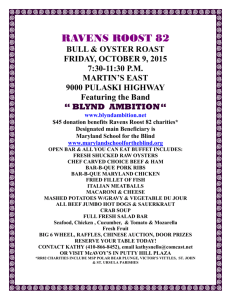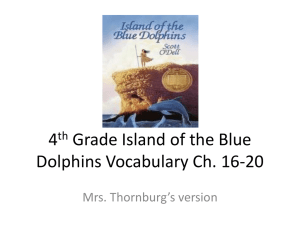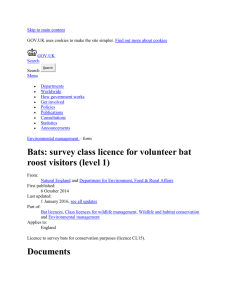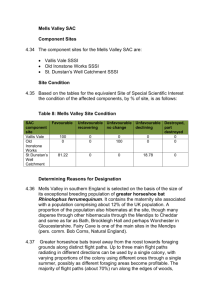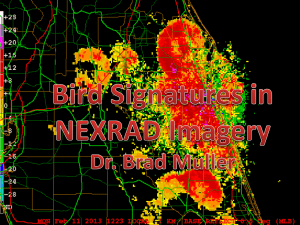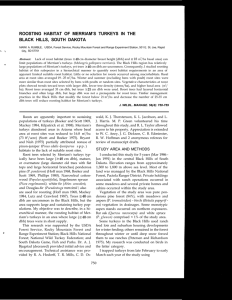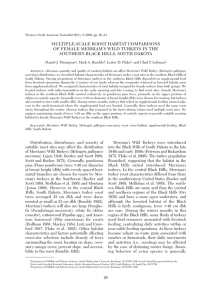Odour cues influence predation risk at artificial bat roosts in urban
advertisement
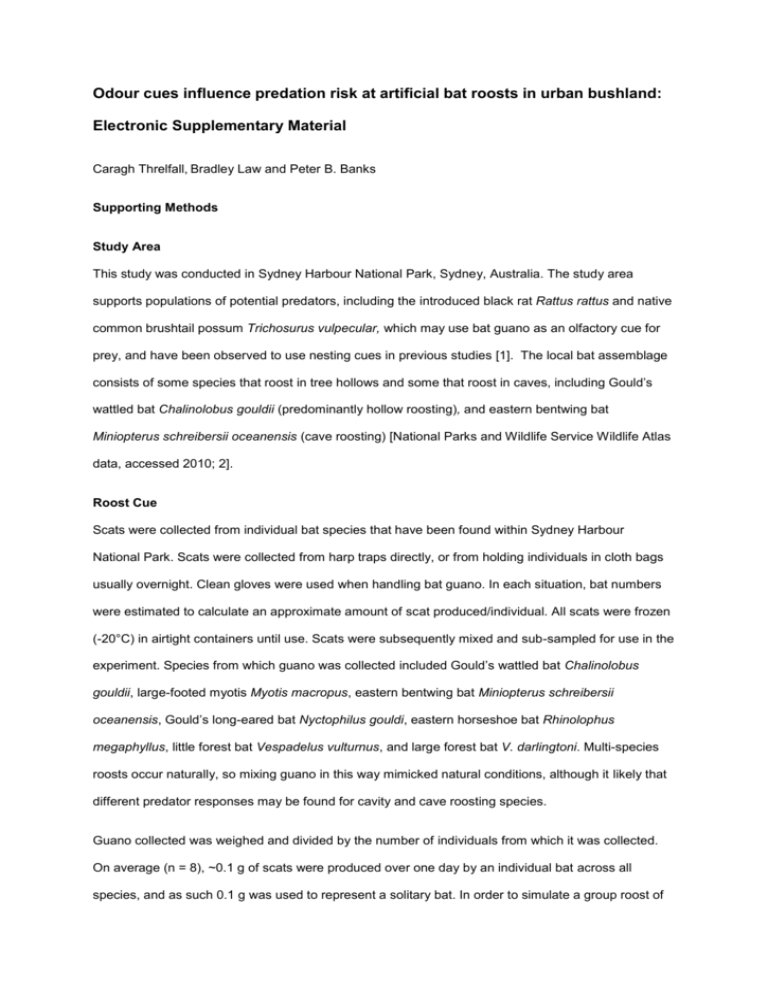
Odour cues influence predation risk at artificial bat roosts in urban bushland: Electronic Supplementary Material Caragh Threlfall, Bradley Law and Peter B. Banks Supporting Methods Study Area This study was conducted in Sydney Harbour National Park, Sydney, Australia. The study area supports populations of potential predators, including the introduced black rat Rattus rattus and native common brushtail possum Trichosurus vulpecular, which may use bat guano as an olfactory cue for prey, and have been observed to use nesting cues in previous studies [1]. The local bat assemblage consists of some species that roost in tree hollows and some that roost in caves, including Gould’s wattled bat Chalinolobus gouldii (predominantly hollow roosting), and eastern bentwing bat Miniopterus schreibersii oceanensis (cave roosting) [National Parks and Wildlife Service Wildlife Atlas data, accessed 2010; 2]. Roost Cue Scats were collected from individual bat species that have been found within Sydney Harbour National Park. Scats were collected from harp traps directly, or from holding individuals in cloth bags usually overnight. Clean gloves were used when handling bat guano. In each situation, bat numbers were estimated to calculate an approximate amount of scat produced/individual. All scats were frozen (-20°C) in airtight containers until use. Scats were subsequently mixed and sub-sampled for use in the experiment. Species from which guano was collected included Gould’s wattled bat Chalinolobus gouldii, large-footed myotis Myotis macropus, eastern bentwing bat Miniopterus schreibersii oceanensis, Gould’s long-eared bat Nyctophilus gouldi, eastern horseshoe bat Rhinolophus megaphyllus, little forest bat Vespadelus vulturnus, and large forest bat V. darlingtoni. Multi-species roosts occur naturally, so mixing guano in this way mimicked natural conditions, although it likely that different predator responses may be found for cavity and cave roosting species. Guano collected was weighed and divided by the number of individuals from which it was collected. On average (n = 8), ~0.1 g of scats were produced over one day by an individual bat across all species, and as such 0.1 g was used to represent a solitary bat. In order to simulate a group roost of 10 roosting bats, 1 g of cue was used. Control roosts were identical to other treatments, where water was used instead of odour. Artificial roosts were made out of enclosed plastic containers, where an entry hole of approximately 6 x 6 cm was cut into the side. The containers were painted dark brown to reduce their visual conspicuousness. Roosts were placed > 50 m apart and attached to a tree (>10 cm DBH) via cable ties approximately 1.5 - 2 m above the ground. Australian bats roost at varying heights from the ground [3, 4], and this height was chosen to reasonably mimic natural conditions and allow for ease of monitoring. Roosts were placed in areas considered likely to support roosting bats, and were distributed within an area of coastal woodland where all roosts were in areas considered to be equivalent habitat. Two methods were used concurrently to detect roost visitors. Non-sulfurous plasticine (Rainbow modelling clay, Newbound Pty Ltd) was placed inside the entrance to the roost to record indirect signs of visitation, such as footprints, claw, beak and teeth marks. Roosts were also monitored directly using motion censored infrared video cameras (Scoutguard 550v set to maximum sensitivity), to record predator identity, behaviour and time of visit. Each roost was inspected each day, and the plasticine smoothed over if it had been disturbed. A visit was defined by any investigative behaviour to the artificial roost, recorded via either monitoring method. A visit to a roost was classified as independent from the camera data, if occurring greater than three minutes from a previous visit by the same species. Visitation may also be influenced by local hollow availability, and roost height, which was not measured in this study, however may provide additional insights into the intensity of roost predation. We used 90 artificial roosts were used to simulate natural roosts (n=30 solitary, 30 group and 30 control roosts). Odours were deployed to simulate roosts of differing group size (solitary or group), and longevity (single use, or re-used on consecutive days). The odour cue (0.1 g, 1 g or water = control) was placed inside the roost entrance. The level of visitation by other species to these roost types was compared to control roosts. One replicate from the ‘group’ treatment was removed from the design due to site inaccessibility. In addition to the odour cue placed inside the roost, an additional dilute cue was sprayed on the surface of the roost entrance to facilitate olfactory detection by potential predators. Odour used on the entrance to the roost consisted of 0.05 g.L-1 for solitary roosts, and 0.5 g.L-1 for group roosts. Half of all treatments (15 replicates) were re-applied daily for five days, to represent the re-use of the roost (‘re-used’ treatment). In the other half, the faeces were only applied on the first day to mimic switching (‘switched’ treatment). Renewed odour included both the scats inside the roost, and the diluted odour on the entrance of the roost. Water was resprayed as a control. The roosts were placed in each area seven nights prior to the start of the experiment to habituate animals to the experimental equipment. Odour (solitary, group or control) was placed in and on the roost on day eight, and roost visitation was monitored the following five days. Analyses were carried out using JMP (SAS Institute, version 7.0), following [5] and [6]. All data have been deposited in Dryad (doi:10.5061/dryad.r01j0). References 1. Price C.J., Banks P.B. 2012 Exploiting olfactory learning in alien rats to protect birds’ eggs. Proceedings of the National Academy of Sciences 109(47), 19304-19309. (doi:10.1073/pnas.1210981109). 2. Churchill S. 2008 Australian bats. Second ed. Sydney, Australia, Allen and Unwin. 3. Lumsden L.F., Bennett A.F., Silins J.E. 2002 Selection of roost sites by the lesser long-eared bat (Nyctophilus geoffroyi) and Gould's wattled bat (Chalinolobus gouldii) in south-eastern Australia. Journal of Zoology (London) 257, 207-218. 4. Threlfall C.G., Law B., Banks P.B. in press Roost selection in suburban bushland by the urban sensitive bat Nyctophilus gouldi. J Mammal. 5. Cox D.R. 1972 Regression models and life-tables. Journal of the Royal Statistical Society Series B (Methodological) 34(2), 187-220. 6. Kaplan E.L., Meier P. 1958 Nonparametric estimation from incomplete observations. Journal of the American Statistical Association 53(282), 457-481.

